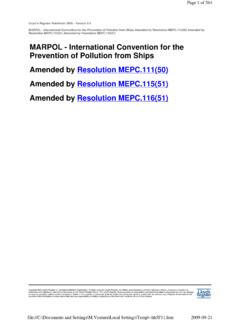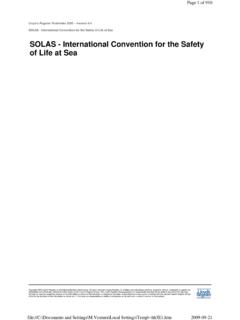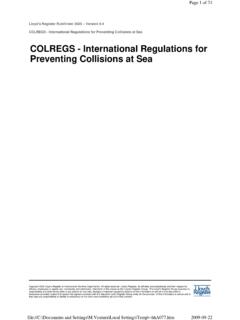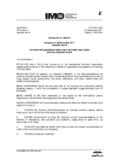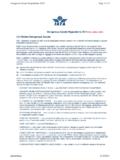Transcription of Tankers - ULisboa
1 1 TankersManuel VenturaShip Design IMSc in Marine Engineering and Naval Tankers2 Main Types of Tankers (1) Oil Tanker tanker for the carriage of crude-oil Shuttle Tanker-tanker ship for the carriage of crude-oil directly from the offshore oil fields to terminals or refineries. Product Tanker -tanker for the carriage of refined products derived from crude oil (gasoline, Diesel oil, jet fuel) from the Tankers3 Main Types of Tankers (2) Chemical (Parcel Tanker)-tanker for the carriage of chemical products in bulk. Simultaneous carriage of different types of cargo More recent ships are equipped with clad tanks (steel coated with stainless steel) or completely built in stainless steel. Can carry a large number of different types of cargo Each tank has its own load/discharge system with separate pumps and piping Tankers4 Main Types of Tankers (3) Liquefied Gases tanker for the carriage of condensed gases The gases are kept in the liquid state due to high pressures or to very low temperatures, in tanks with highly efficient insulation.
2 More relevant cargo types: LNG(Liquefied Natural Gas) - mainly methane, with temperatures that can reach the 163 C. LPG(Liquefied Petroleum Gas) - This gases have a low boiling point (-44 to 0 C) and high vapor pressure. They are carried at environment temperature in pressurized tanks independent from the ship s hull, or at reduced temperatures, at atmospheric pressure. Examples: propane, butane, propylene, butylene3 Oil Tankers6 Oil Tankers Typical SizesProductstanker for refined products with 35,000 t < DW < 70,000 t. Average price abt. 32 Mill. US$Handysize20,000 t < DW < 30,000 t HandyMaxDW ~ 45,000 dwt Aframax80,000 t < DW < 119,000 t (American Freight Rate Association). Average price abt. 44 Mill. US$.Suezmaxthe largest tanker that can cross the Suez Canal, fully loaded (120,000 t < DW < 180,000 t).
3 Average price abt. 54 Mill. US$VLCC(Very Large Crude Carrier) 260,000 t < DW < 330,000 t. Average price abt. 85 Mill. US$.ULCC(Ultra Large Crude Carrier) DW > 330,000 Tankers7 Ships on Order (2010) Tankers8 Shuttle Tankers Generally they are conventional Tankers equipped to be moored to a discharge buoy at deep sea Load their cargo directly from the oil field, where it is stored in reservoirs, where generally the sulphur is removed. Require a great maneuvering capability in comparison with the traditional Tankers , and generally are equipped with dynamic positioning systems. Can be easily identified by the raised compartment at the bow and ramp to handle the cargo hose. Typically, a shuttle tanker as DW ~ 120,000 t and a service speed of abt. 16 knots, higher that conventional Tankers9 Shuttle Tankers Viktor Titov , an Aframax tanker prepared for bow Tankers10 Product Tankers Carry refined oil products that can be classified into 2 main groups: White products (Diesel oil, gasoline, jet fuels, kerosene, lube oils, etc.)
4 Black products (fuel oils, residual products) Clean cargo tanks characterized by: No structural elements inside the cargo space (double skin) Corrugated bulkheads (transverse and longitudinal) Cargo tanks painted or internally coated Each cargo tank is provided with a segregated cargo system including a submersible pump and its own cargo line to the manifold, on deck The number of possible cargo segregations on board is equal to the number of cargo tanks Typically these Tankers are smaller than the crude oil Tankers , with DW < 70,000 t6 Cargo Tankers12 Crude Oil Crude Oil mineral oil composed by a mixture of hydrocarbons of natural origin, with variable density and viscosity Heavy Crude Oil type of crude oil that exists in zones such as the Orinoco (Venezuela), the banks of Athabasca (Alberta/Canada)and the banks of Olenik (Siberia/Russia).
5 They have the following characteristics: Density close to or even higher than the water High viscosity, can be almost solid at environment temperature Can not be produced, carried and refined by the conventional methods Generally they have high content of sulphur and some metals such as the nickel and the Tankers13 Heavy Grade Oil In MARPOL Convention the designation of Heavy Grade Oil (HGO) is assigned to the following products: Heavy fuels with density at 15 C > 900 kg/m3 Fuel Oils with Density at 15 C > 900 kg/ m3, or Kinematic viscosity at 50 C > 180 mm2/s Bitumen, tar and its Tankers14 Crude Oil Classification According to the Origin Europe/North Sea light product, reduced viscosity, black. West Africa -more viscous than the one from North Europe, becomes more viscous at temperatures < 19 C and volatizes quickly at temperatures > 27 C.
6 South America heavy product, viscous Persian Gulf Asia/China very heavy Tankers15 Oil Products A large variety of products is obtained from the refined oil The oil products can be classified as: White Products Gasoline Petroleum Jet-fuel Gas oil Aromatics Black Products Diesel Oils Fuel Oils Tankers16 Some Definitions and Units Barrel (bbl) - Measure of capacity commonly used for crude and refined products. Its historical origin were the wooden barrels that were used to transport the first crudes extracted for commercial barrel = 35 imperial gallons = 42 US gallons = 159 liters. Specific Weight -the standard temperature used by ASTM (American Society for Testing Materials) for the determination of the specific weight is C (60 F). API Grade - scale adopted by the American Petroleum Instituteto measure the oil density.
7 The oils with a lower specific weight have higher API by the expression:API Grade = ( weight at 60 F) Tankers17 Evolution of the Crude Oil Prices (1947-2006)Systems for Tankers19 Cargo Systems Pump Room 1 pump for each cargo segregation (typically 3 or 4) Centrifugal pumps of large capacity The electrical driving engines are located in the Engine Room Submersible Pumps 1 pump for each cargo tank 1 portable pump Piping system entirely above the main Tankers20 Arrangement of the Cross-Over Refer to Recommendations for Oil Tanker Manifolds and Associated Equipment , Tankers21 Other Cargo Systems (1)Bow Loading System(BLS) Used in shuttle-tankersto receive the crude oil from cargo terminals, from cargo buoys and from FPSO's and FSU' shape of the bow of these ships must be adapted to the installation of these Tankers22 Other Cargo Systems (2)Stern Discharge System(SDS) Installed aft in FSU's and FPSO's to discharge the cargo to shuttle- Tankers .
8 The system is supplied with a storage drum for the discharge hose or, in alternative, with horizontal storage of the hose in a conveyorStern Loading and Discharge System(SLDS) Results from the development of BLS and SDS which allow a ship to load/discharge cargo through the bow extremity. It is an attractive alternative from the economical point of view for the multi-purpose ships. Tankers23 Other Cargo Systems (3)Submerged Turret Loading (STL) Technology for offshoreload of crude oil. With the STL system the loading operations can be carried out in worse sea states then with the previous systems. The STL Buoy moored by a cable is lifted to a recess in the ship s bottom and allows the effective mooring of the ship The STL Buoy is composed by a tower and a system that allows the free rotation (swivel) of the ship due to the atmospheric conditions.
9 Tankers24 Systems for CargoSubmerged Turret Production (STP) Innovative concept for FPSO's that uses STL technology together with a high-pressure multiple way system, disconnectable, supplied by Framo Tankers25 Ballast SystemsThe ballast system can also be based on submerged Tankers27 Protection of the Fuel Oil TanksVoid space or ballast water tank protecting fuel oil tank as shown in Figure, need not be considered as "cargo area" defined in Reg. II-2 even though they have a cruciform contact with the cargo oil tank or slop void space protecting fuel oil tank is not considered as a cofferdam specified in Reg. II-2 There is no objection to the locations of the void space shown in the Figure, even though they have a cruciform contact with the slop Tankers28 Inert Gas System (IGS) The system can be fed by the exhaust gases, by an inert gas generator or by Tankers29 Mixture Diagram Hydrocarbons/Air/Inert GasFor example, if the discharge is at point F, and if this atmosphere is open to the outside there would be a mixture with the air (oxygen) following the line FA which is not advisable, because it would pass through the dangerous zone.
10 Point A corresponds to the breathing air (~20,8% Oxygen). The gray zone is the dangerous one, starting at about 11% oxygen Normally on board it is used a safety margin, working with 5% - 8%. Tankers30 Mixture Diagram Hydrocarbons/Air/Inert Gas The typical procedure is to introduce inert gas until the point H, and then there is no more concern with the oxygen because the mixture follows the line Tankers31 Cargo Tank Venting System SOLAS Regulations 59 e Tankers32 Cargo Tank Venting System On 1st July of 1998 it became a SOLAS requirement that the Tankers are equipped with a secondary mean to avoid over/under pressure in the tanks in the eventuality of the failure of the main pressure/vacuum (p/v) system. Also required are devices that guarantee that the valves are opened before any loading or ballasting Tankers33 Crude Oil Washing System (COW) Rotative washing Tankers34 Cargo Heating System (1) The cargo tanks and the slop tanksare equipped with a cargo heating system The purpose of the system is to heat the crude up to a temperature at which the viscosity will allow it to handled by the cargo pumping Tankers35 Cargo Heating System (2) The heating can be obtained from the circulation of steam or a thermal fluid (Ex.)


